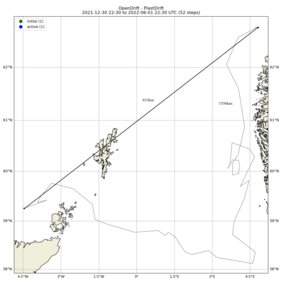A lot of the plastic litter in the sea ends up there, because there is no appropriate waste management system in place, or these are not used properly. However, fishing gear – nets, trawl nets and fish traps– are placed in the sea for the sake of catching fish and shellfish. Seas and oceans are a tough environment for fishing gear, which have been made to endure extreme strains. But if damaged and worn out fishing gear are not repaired in time or removed from use and disposed correctly, they might end up as ghost gear in our seas and oceans. And since they have been made from durable materials, they can continue to catch fish and cause other harm for the marine environment, until they are removed from the sea.
But how far can this kind of ghost gear, derelict fishing gear that is torn away and lost during fishing operations, travel, where does it end? That is what we set to find out with our second Plastics in the sea campaign case, which originates in Northern Scotland, close to Thurso. Port of Scrabster in Thurso is a busy fishing and cargo port, which also connects mainland Scotland to the Orkney Islands with several daily ferry departures. These waters are a busy fishing ground and thus a very potential location, where pieces of fishing net might get lost and turn into ghost gear. In our scenario, a fishing vessel lost a piece of net, about 2 meters wide and 3 meters long, in this area on the night of 30th of December 2021.
The simulation had its beginning on the north of Scotland, a bit to the west of Orkney Islands, at 4.4. West and 59.2 North. But the ghost gear did not stay this area. The strong currents in this area took it north of Orkney Islands and into the North Sea and then to the coast of Western Norway. From there it headed to North. By beginning of June, about 5 months after the start of the simulation, the virtual ghost gear was still close to the west coast, but now heading now towards the Norwegian Sea. It was about 630 km northeast from the starting point, but had traveled close to 1600 km in the course of the five weeks. As it can take hundreds of years for the fishing net to disintegrate totally, this virtual net would have been only in the very beginning of its destructive career as marine litter. Drifting fishing gear can be deathtraps to marine mammals and fish, but as they are in sea, they gradually disintegrate into microplastics as well. Therefore, it is of utmost importance, that fishing nets are well cared for and disposed appropriately, as their best before date approaches. Collection of the used nets and re-use of them is important, not just for the sake of keeping nature clean of them, but it also makes sense from the point of view of resource-efficiency.

